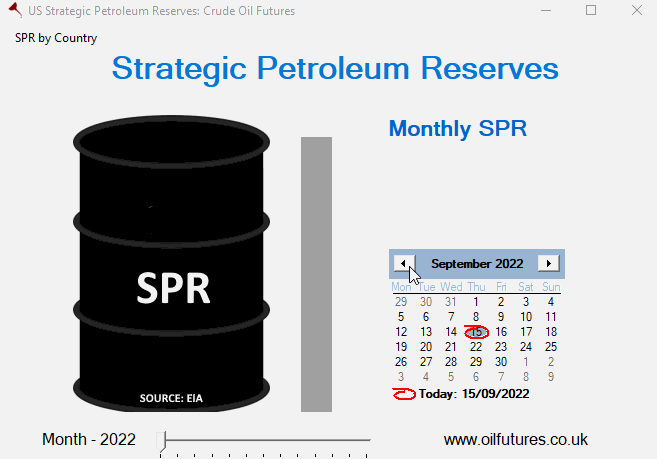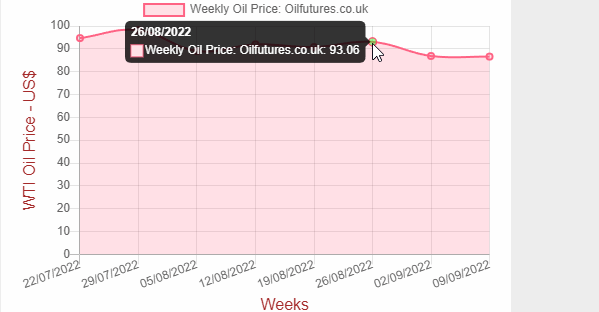 |
| US Strategic Petroleum Reserves - 2022 |
The prices of crude oil seem to have found their respective new equilibrium during the past few weeks, having fluctuated wildly at the early stages of the recent price 'crash'.
The prices of WTI and Brent have settled slightly above $80 and $90 respectively.
As of 08:30 GMT on Friday, the prices of WTI, Brent and LNG, liquified natural gas, stood at $85.64, $91.52 and $8.23 respectively. The price of natural gas, meanwhile, oscillated chaotically on Thursday between $8 and $9, before settling at, just above $8.00.
In recent weeks, the price of natural gas has been a key factor that determined the price of crude oil, as industrialists started switching to the latter when the former goes through the roof; its influence appears to have eclipsed that of the US crude inventories in recent months.
The substantial US crude build, reported by the API, American Petroleum Institute, followed by a moderate build reported by the EIA, US Energy Information Administration, this week, for instance, did not influence the price fluctuation that much, although it reflects the inflationary pressure suffered by the customers in the world's top energy consuming nation.
The energy crisis in Europe, meanwhile, is far from over, despite the EU members getting their individual gas reserves close to 80% - a goal set by the EU to avert a full-blown energy crisis during the winter; those who made the estimates, according to analysts, assume - and pray, too - that the temperatures will stay modest during the period so that the Europeans can weather the storm.
Since no weather model can predict the temperature changes in the next four months, the estimates remain exactly as what they really are - just estimates. In short, folks in the northern hemisphere are at the mercy of nature for long, cold, dark months ahead.
After the war in Ukraine broke out, the European governments just followed the American script to the letter, fearing a backlash for resisting the dictates.
Since Europe is on the verge of a serious energy crisis, the backroom diplomacy seems to be active than ever before while dealing with the US. The prospect of abandoning a cap on Russian gas that was hailed as a victory a few days ago, is case in point.
As far as the US is concerned, the unwavering obedience of Europe magnifies the burden of its obligation to assist the latter in its hour of need; the US is under pressure to help Europe to ease the gas crisis, but it is much easier said than done, especially when the consumers in the US suffer from high energy costs too.
In order to address the issue of high oil prices, the US tried for months at first to get the UAE and Saudi Arabia, two of its most trusted allies in the Middle East, on board in order to elevate the global crude oil output, all but to no avail.
Then it tried to revive the JCPOA, 2015 Iran nuclear deal, since the Biden administration came to power; it, too, now is all but dead.
Having failed every measure at its disposal, the US resorted to the 'nuclear option' by releasing its own Strategic Petroleum Reserve, SPR, along with its allies - and political foes as well; the contribution from the rest, however, paled into insignificance, compared to what the US has been releasing.
Having sensed the wrath of the US consumers over rising cost of living, in March, 2022, President Biden announced that the US would release 1 million barrels of crude oil from its SPR every day for six months until the end of October - at least 180 million barrels during the period; in certain weeks, the authorities released much more than what they initially planned, in response to the evolving market demands.
As of 30 August, the SPR stood at 44,9998000 barrels, down from 558000000 barrels in January, 2022 - a drop of almost 26%. The US administration has not been explicit about its next move, when the current releasing of SPR ends in October; analysts believe that the US has no choice other than continuing the release of the crude stocks to address the crisis at pumps - at least partially.
The SPR of the US, started in 1975 in response to the oil embargo initiated by the Arab nations against the West, is the largest emergency crude stocks in the world.
It is never meant to be used as a 'tool' to keep the inflation at bay. In this context, its excessive use in the current circumstances can result in a situation that could potentially be a breeding ground for President Biden's political opponents.
In short, the US SPR is not being used strategically, according to critics of the move; it is more or less knee-jerk response, when almost all options have been exhausted. The Biden administration, however, can attribute the fall in oil prices for three consecutive weeks to the release of SPR, in order to silence the critics.
Had it not been for the very high price of natural gas, the fall in oil price would have been more dramatic.
The steep rise in inflation is not a unique phenomenon in the Western world alone; nor is it just confined to the big consumers of oil and gas. On the contrary, it is causing problems for big oil producers too.
In Saudi Arabia, the world's top oil exporter, for instance, the CPI - consumer price index - rose from 2.7% in July to 3% in August, compared to what it was last year; economists attribute it to the rising costs of transport, food and beverages.
Both the UAE and Saudi Arabia recently allocated billions of dollars to alleviate the difficulties faced by its own citizens due to high inflation.
All in all, the stakes for both oil producers and consumers have never been higher. It's high time a sensible balance is struck that is acceptable to both sides in the energy equation - before it is too late.







